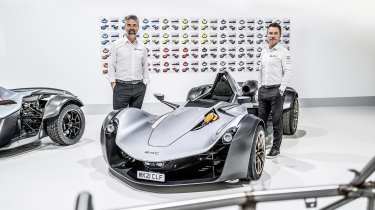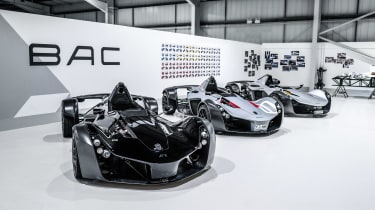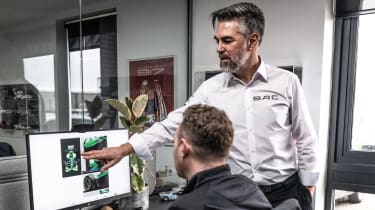BAC's hydrogen fuel-cell future – why this British sports car maker isn't going electric
We talk to BAC about their plans for a fuel cell-powered Mono
In the road-going world, there isn’t a more focused driver’s car than the BAC Mono. It looks like a single-seat racing car wearing lights and number plates and drives like one too, holding many production car lap records. Since its launch a decade ago, just shy of 150 Monos have been shipped to more than 40 countries and it has been carefully, methodically evolved. Today’s Mono R is even more aerodynamic, more powerful and lighter than the original.
It’s a pure driver’s car with minimal frills – ‘a car designed to go from A to A’. So what kind of Mono does BAC plan to build for the upcoming ban on the sale of new petrol- and diesel-engined cars, from 2030 in the UK and recently confirmed in the EU from 2035? Caterham and Morgan are looking at making battery electric vehicle (BEV) sports cars while Ariel is on the verge of launching its ‘Hipercar’, a BEV supercar (see issues 297, 299 and 298 respectively). BAC has a different plan.
BAC – Briggs Automotive Company – was created by Neill and Ian Briggs (pictured right and left respectively). The brothers had established a design and engineering consultancy, working for premium brands including Porsche and Mercedes, before creating and launching the Mono. ‘The Mono was never designed to be transport, it’s not missing a seat,’ says Ian, who is responsible for design. Yet despite the single-minded focus of the Mono, their approach to its development over the last decade and the innovations they have pursued to save weight have applications in vehicles generally.
When the original 280bhp 2.3-litre in-line four was replaced in 2015 by a 2.5-litre with 305bhp, it brought with it a drive-by-wire throttle that allowed the introduction of a number of electronic aids that its wealthy customers had come to expect, such as launch control, scalable traction control and an electronic handbrake. Simultaneously, BAC began to introduce some of the lightweighting they had been working on, offering a carbon-ceramic brake package and ‘carbon-hybrid’ wheels.
These hybrid wheels save a massive 2kg per corner, but rather than being made wholly out of carbon, it’s only used for the rim. ‘The most important place to save weight is the rim. That’s the furthest from the centre,’ says Ian. ‘The centre piece we can change every year if we want. It’s a CNC machined part. We can change the material, we can do all kinds of innovation there. The point of the niche vehicle sector is we are incubators and accelerators for new technology because we’re small, we’re agile, we can make quick decisions, we can react quickly, we can fail quickly, but more often than not succeed.’
Lightweighting benefits all types of vehicle. ‘With regards to electric vehicles, anything that can be done to save weight has an automatic correlation to the range extension, and obviously range is one of the fundamental issues these days,’ says Neill. ‘So we started to look at other new technology coming through and in 2013/14 we started investigating graphene.’
This extraordinary material, isolated and investigated at Manchester University, of which Neill is an alumnus, has many remarkable properties. When used in carbonfibre panels, it adds strength for very little weight. BAC’s graphene project, partly funded through APC (Advanced Propulsion Centre) and the Niche Vehicle Network, resulted in lighter carbonfibre panels on the Mono R, launched in 2019. Another property of graphene is that it conducts electricity, which offers more opportunities. ‘Not only can you make panels structurally the same but lighter,’ says Ian, ‘you can also pass electricity through it, so you can start thinking about deleting the wiring loom…’
Another material they’re developing and proving is niobium, which is a bit like graphene for metal. ‘Niobium was discovered in the early 18th century and is mined predominantly in Brazil by a company called CBMM,’ says Ian. ‘When it’s added into the high-strength steel alloy mix in very, very small amounts it enhances the structural properties, doubling yield and tensile strengths. For a Mono chassis with the same structural performance it’s 18 per cent lighter. In terms of its usage and licensing we can talk quite freely to other manufacturers about how we’ve created lightweight and safer structures.’
Regarding the power source of a Mono built for the upcoming regulations in the UK and EU, a battery electric Mono using current technology was a non-starter. ‘It would weigh 50 per cent more and the joy of a track-focused supercar is its agility and responsiveness through corners,’ says Ian. The closest thing to an electric Mono wasn’t encouraging, he adds. ‘State of the art is a Formula E racer. It’s 900kg, it will just about do a 30-minute race, it costs a million euros and at Goodwood it was three or four seconds slower than our car up the hill. So we’re gonna go slower for half an hour. It just wasn’t a product we could sell.
‘The “a-ha!” moment for Neill and I was with the fuel cell,’ says Ian. That’s what powers the e‑Mono concept, a feasibility study funded partly by the Niche Vehicle Network and developed in conjunction with British fuel cell specialists Viritech, whose 1200bhp Apricale hypercar concept we featured in evo 294. The e‑Mono currently exists only in the virtual world but has been accurately modelled. BAC says it weighs 149kg more than the 342bhp, ICE-powered Mono R but that there is the potential to quickly reduce this by a third, which would mean a zero-emission Mono weighing 655kg, less than 100kg more than the Mono R. The lightest of the proposed battery electric supercars, the Ariel Hipercar, is aiming for 1600kg, the Lotus Evija for 1700kg, while even the McMurtry Speirling, the tiny, radical, British-designed BEV (see evo 294), is aiming to be just under 1000kg.
The appeal of the hydrogen fuel cell powertrain to BAC is obvious then, but it’s great for packaging as well as weight. All the components of the fuel cell drivetrain can be incorporated into the Mono’s design, meaning that the hard-won refinements and improvements in engineering and aerodynamics can be carried over. In the e‑Mono concept, the small battery pack goes behind and beneath the single driver’s seat and is a structural component, the fuel cell is mounted above it and its compressor is located inside what is the air intake pod of the ICE version. The battery delivers the equivalent of 264bhp, the fuel cell 107bhp, for a total of 371bhp.
‘You’ve got this constant energy that’s coming from the fuel cell and then you’ve got this additional energy from the battery as and when you need it,’ says Neill. ‘You size your energy sources according to your usage.’ A truck or a ship would have a large battery to provide the push to get their mass moving, for example. ‘So where we are at is we’ve got an application of that equation that works perfectly for a high-performance car. The battery we’re investigating is the same as in Formula 1 – high density, high deploy, high regen – and the size of a couple of computers.’
A fuel cell car produces only water as a by-product and can refuel much faster than a BEV can recharge – it’s like filling up with petrol or diesel – and there aren’t the same issues of maintenance of performance on a track because the battery always works in its optimum range.
A key objective set by BAC was that the e‑Mono should match or better the Silverstone lap time of the Mono R. From the outset, BAC designed the Mono in the computer and now uses a ‘digital twin’ to gauge the effect of any changes. ‘Obviously, it’s only as good as the quality of the data that goes in,’ says Neill, but for the last two or three years they have been uploading all the data from real world testing and also have measured data on their actual tyres from Pirelli. ‘We’re within a couple of per cent now, which is very, very good,’ says Ian. ‘We can change parameters such as horsepower, torque, grip, damper rates and gearing.’
It’s this level of data that has allowed them to build a fuel cell Mono in the virtual world, drive it on the simulator and predict, with some confidence, that the e‑Mono would lap Silverstone in 2:06.3, shaving two seconds off the lap time of the Mono R.
However, a fuel cell car is no more characterful than a BEV and as well as missing out on a characterful engine note there are no gears to engage with either. ‘I’m not disappointed when I think of this future,’ says Ian. ‘Neill and I both come from karting and that was just one gear. I’m excited about what we can do with torque vectoring, which gives you infinite adjustability, into a corner, mid-corner, on the exit, to make the car behave exactly how you want.’ The scope to influence the dynamics with torque vectoring is greatly enhanced on e‑Mono because its specification includes a small, 3kg electric motor on each front wheel. These motors also help bring down the 0-62mph time from an already astonishing 2.5sec on the Mono R to just 2.2sec.
Right now, a big issue for hydrogen fuel cell vehicles is there’s very limited availability of liquid hydrogen, while the roll-out of EV charge points gathers pace. ‘If tomorrow BP and Esso said, “Right. We’re going to put a hydrogen fuelling station at every gas station by the end of the year,” well then the battle’s over, isn’t it?’ says Ian. ‘Straightaway, there’s no more anxiety about range. If that happens, then great, we’re perfectly placed. But if someone discovers a magic battery that suddenly weighs a tenth of what they currently do, we’ll take the fuel cell out, make the battery a bit bigger and now we’ve got a dedicated EV.’
BAC’s next move is to take the e‑Mono to proof-of-concept stage. Meanwhile the ICE Mono lives on. Indeed, with 50 export territories around the globe, the company could survive by supplying ICE Monos alone and has a secure supply of engines to do so.
‘We will continue serve Mono enthusiasts around the world with the product that best suits their market and market restrictions,’ says Ian, ‘and we will continue to be agile in our adaptation and evolution, especially for our dominant markets in the US and Far East. In the future it could be that even enthusiast drivers choose to use a BEV for normal use, maybe even an autonomous vehicle. When that inevitably happens, the car as we know it will become a pure leisure item, much like a piece of precision sporting equipment. At that time the purity and definition of purpose of Mono will make it perfectly placed as the definitive way to enjoy sustainable, efficient performance driving, be that fuel cell, BEV or via synthetic fuels.’ L






